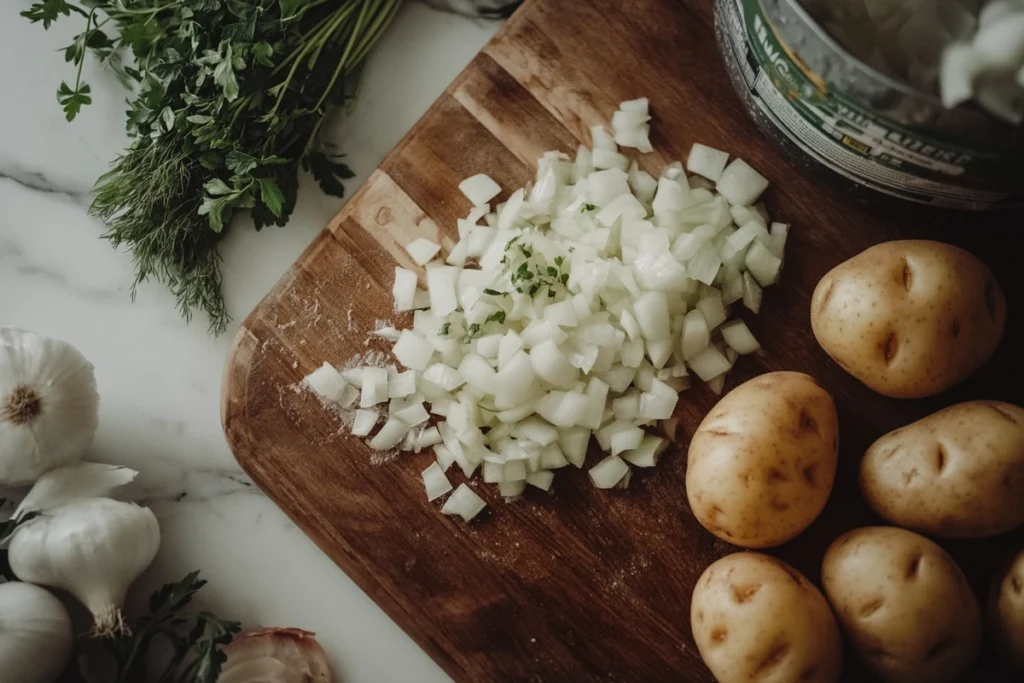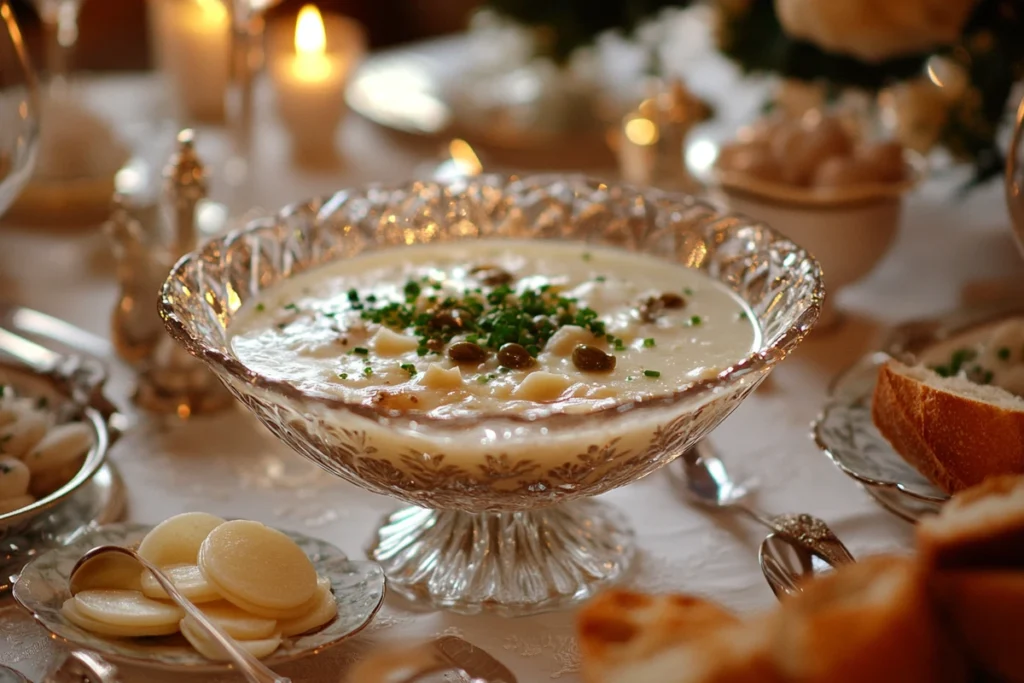Enjoy our comprehensive guide to creating a delicious potato soup recipe. Learn tips, flavor ideas, and simple steps for a hearty bowl anytime.
Introductory Description
Experience warmth and satisfaction with a potato soup recipe that’s easy, flavorful, and comforting. Dive into our tips, tricks, and creative variations today.
Detailed Professional Outline
- Understanding Potato Soup and Its Popularity
- Origins and reasons for universal appeal
- Versatility across diets and preferences
- Common variations and cultural twists
- Why Choose a Potato Soup Recipe
- Benefits of an economical, filling dish
- Ease of customization (vegetarian, meaty, or dairy-free)
- Tips for pairing soup with other courses
- Essential Steps for Potato Soup Recipe
- Key ingredients: potatoes, aromatics, liquid base
- Basic cooking equipment and setup
- Preliminary steps for effective meal prep
- Key Tips for Successful Potato Soup Recipe
- Adjusting thickness, flavor, and creaminess
- Avoiding lumps and ensuring consistent texture
- Balancing seasonings like salt, pepper, or herbs
- Serving Ideas for Potato Soup Recipe
- Garnishes, toppings, and condiments
- Complementary side dishes or main courses
- Presentation tips for a pleasant table setting
- Common Mistakes to Avoid
- Overcooking or under-seasoning
- Selecting the wrong potato varieties
- Neglecting the potential for lumps
- Enhancing Your Potato Soup Recipe
- Protein additions, from bacon to chicken
- Substituting dairy or adding cheese
- Extra herbs, spice mixes, or flavor boosters
- Storing and Reheating
- Tips for fridge or freezer storage
- Best practices for warming soup without losing taste
- Maintaining desired consistency upon reheating
- Practical Variations of Potato Soup Recipe
- Cheesy or loaded potato soup
- Lighter, broth-based renditions
- International influences, such as adding spices or regional vegetables
- Frequently Asked Questions (FAQ)
- What can I add to potato soup to add flavor?
- What is the best thickener for potato soup?
- Do you need to cook potatoes before putting them in soup?
- Why does my potato soup have no flavor?
- Conclusion
- Summarizing the major points
- Encouraging experimentation and personal flair
I. Understanding Potato Soup and Its Popularity
Potato soup stands among the most beloved comfort foods in many culinary traditions. Indeed, cooks worldwide rely on potatoes for their gentle flavor, low cost, and easy availability. Another reason behind the popularity of a potato soup recipe is that it welcomes a variety of ingredients. You can keep the soup minimalistic with potatoes, onions, and a little cream, or you can jazz it up with bacon bits, shredded cheese, or tangy spices. Because potatoes are mild, they readily absorb different seasonings, letting you adapt your soup to diverse tastes.
Furthermore, potato soup emerges as an economical choice. Families looking for budget-friendly meals find that a bag of potatoes goes a long way. Combined with water or stock, plus a handful of aromatics, you get a filling dish. Additionally, the soup’s texture is customizable: if you prefer a chunky style, simply mash some potatoes while leaving the rest intact. On the other hand, if you love velvety results, blend it entirely. This meal also suits a broad audience, from children who crave creamy consistency to adults searching for hearty warmth on cold nights. Meanwhile, you can incorporate vegetarian alternatives or meaty add-ins. Indeed, a potato soup recipe can cross dietary lines effortlessly. Because of all this, it’s no wonder that many see potato soup as a staple in home-cooked comfort cuisine.
On a cultural level, many countries feature something akin to potato soup. In some places, it might be spicier, or in others, it might be loaded with sausage. The basic premise remains the same: simmer potatoes until tender, infuse them with flavors, and create a smooth or chunky blend. Another advantage is that leftover soup often intensifies in flavor by the next day, making it a wise meal-prep candidate. If you’re hosting a cozy dinner, serving potato soup with a side of bread or pairing it with Avocado Toast with Feta can create a delightful synergy. Ultimately, a simple potato soup recipe resonates across cultures and generations.
II. Why Choose a Potato Soup Recipe
Comfort is the hallmark of any potato soup recipe. The texture often resembles a thick, creamy blanket that warms you from within. Another reason to choose potato soup is its forgiving nature. Even novices in the kitchen can achieve a delicious outcome. Because potatoes break down easily under heat, minor mistakes—like an extra pinch of salt or a slightly longer simmer—often remain unnoticed. Additionally, if you accidentally over-thin the soup, you can fix it quickly by mashing additional potatoes or incorporating a thickener.
Financially, potatoes are cost-effective. Families with limited grocery budgets frequently rely on a potato soup recipe that can feed multiple people. Meanwhile, you can serve it as a main course or a side dish, depending on your needs. Pair it with a small salad or a grilled sandwich for a hearty lunch. Another approach is presenting it as part of a multi-course dinner. The soup’s mild profile complements bolder flavors found in grilled meats or tangy sauces. If you crave more variety, you can also try serving it alongside Zucchini Pasta for a fun blend of comforting soup and refreshing vegetables.
Moreover, the dish is quite versatile for those with dietary limitations. By swapping out cream for coconut milk, you can keep it lactose-free. Another example is subbing turkey bacon for regular bacon to reduce saturated fat. Essentially, a single potato soup recipe can transform into different variations suitable for health concerns or personal tastes. Because the base is so neutral, it welcomes experimentation. If you want a robust flavor, incorporate smoked paprika or curry powder. Conversely, if you prefer a mild approach, keep spices minimal. Indeed, potato soup’s universal charm lies in its capacity to adapt to all sorts of culinary whims.
Essential Steps for Potato Soup Recipe

A top-notch potato soup recipe usually starts with fundamental ingredients. Typically, you need potatoes, stock or water, onions, possibly carrots or celery, and seasonings. Some might add dairy—milk or cream—for richness. Below, we outline steps that ensure a creamy yet balanced soup.
Potato Soup Recipe Ingredient Selection
- Choosing Potatoes: Different varieties yield different textures. Russet potatoes break down easily, creating thick, almost mashed textures. Yukon Gold, on the other hand, retains shape better, delivering a smoother, more buttery taste. Another approach is combining multiple varieties for diverse mouthfeel.
- Broth vs. Water: A robust stock (chicken, vegetable, or even beef) imparts deeper flavor. If you prefer a lighter taste, water suffices, but consider adding extra seasonings.
- Aromatics: Onion, garlic, or even leeks help build complexity. Sauté them in oil or butter before adding liquids.
- Fats: Butter or oil forms the base for sautéing. Meanwhile, bacon drippings can intensify savory notes.
When assembling the soup, layer your flavors step by step. Start with onions or leeks. Add in carrots or celery if desired. Then incorporate potatoes and stock. Season lightly at first because the flavor evolves as the soup simmers. Another tip is to add salt gradually, preventing an overly salty outcome.
Potato Soup Recipe Cooking Phases
- Sauté Stage: Soften onions and garlic in melted butter or heated oil. Over medium heat, watch them carefully so they don’t burn.
- Simmer: Pour in stock. Then, add peeled, chopped potatoes. Bring the mixture to a gentle boil, then reduce to a simmer. This stage typically spans 15–20 minutes. Another approach is partially covering with a lid to keep moisture from evaporating too fast.
- Testing Doneness: Check if potatoes are fork-tender. If you prefer a chunkier soup, remove some potato chunks before pureeing. Another alternative is blending a portion for creaminess while leaving some pieces intact for texture.
- Adding Cream or Milk: For a luscious finish, stir in cream or milk near the end. Avoid boiling after adding dairy, preventing curdling.
Key Tips for Successful Potato Soup Recipe
A potato soup recipe can be straightforward, yet small details differentiate a bland soup from an unforgettable one. By following these tips, you ensure consistent, comforting results every time.
Potato Soup Recipe Consistency Adjustments
- Thickeners: Mashing part of the potatoes or adding a cornstarch slurry can thicken the broth. Another method is using a roux of flour and butter.
- Blending: Use an immersion blender for partial or full blending. This yields a creamier base. However, blending too much can create a gluey texture if the potatoes’ starch breaks down excessively.
- Thinning: If the soup is too thick, add more stock or water. Let it simmer a moment to integrate. Over-dilution might weaken flavor, so test frequently.
Potato Soup Recipe Flavor Boosts
- Herbs and Spices: Thyme, rosemary, or even bay leaves can accentuate earthy potato notes. Another approach is a dash of smoked paprika for subtle warmth.
- Cheese: Stir in sharp cheddar, Gruyère, or Parmesan near the end for richness. Another option is topping each bowl with shredded cheese or a swirl of cream.
- Protein: Crisp bacon bits or diced ham can create a meaty undertone. Meanwhile, roasted chicken or turkey can transform the soup into a filling main course.
Because a potato soup recipe forms a mild foundation, each addition stands out. Remember to taste frequently. Another secret is finishing with a splash of vinegar or lemon juice for brightness. Yet, keep it minimal, ensuring you don’t overshadow the inherent comfort factor of potatoes.
Serving Ideas for Potato Soup Recipe
Though a potato soup recipe can hold its own, pairing it or adding garnishes can enhance the overall meal. Because potatoes are neutral, synergy with other elements elevates your dining experience.
Potato Soup Recipe Bowls and Presentation
Opt for wide, shallow bowls to highlight thick, chunky soups. Conversely, deeper bowls maintain heat better for a fully pureed version. Another tactic is presenting the soup in rustic mugs for an informal vibe. Because color might be lacking in pale soups, top with fresh herbs or swirl some cream to add visual interest.
Potato Soup Recipe and Complementary Courses
- Bread: A crusty baguette or cornbread can soak up the soup. Another alternative is cheesy toast served alongside.
- Salads: A crisp, tangy salad cuts through the soup’s creaminess. For instance, a small side of bitter greens with vinaigrette. Another possibility is pairing it with Zucchini Pasta for a contrasting texture.
- Starters: If your meal includes multiple courses, a warm cup of potato soup can come first. Then, follow with a hearty main or even Avocado Toast with Feta. This balances a mealtime spread.
- Beverages: A crisp white wine or a light beer can complement the soup if you’re aiming for a more adult dinner. Another choice is a tall glass of iced tea for non-alcoholic refreshment.

Common Mistakes to Avoid
Even a simple potato soup recipe can falter without careful attention. The mistakes below can hamper flavor or texture. By sidestepping them, you’ll produce a smoother, tastier result.
- Overcooking Potatoes: If boiled too long, potatoes can turn mushy or watery. Another danger is they might disintegrate entirely, losing the hearty texture.
- Undercooking Aromatics: Onions or celery that remain crunchy disrupt an otherwise creamy soup. Therefore, sauté them first to ensure softness.
- Skipping Tasting: Salinity or seasoning levels must be monitored as the soup simmers. Adding salt early, then fine-tuning near the end, helps. Another step is adjusting pepper or herbs.
- Rushing the Puree: If you hurry with an immersion blender or skip blending lumps, you get inconsistent chunks. Because lumps can be unpleasant, do a methodical blend or partial mash.
- Letting It Cool Improperly: If you plan to store leftovers, let them cool in shallow containers. Big pots hamper quick cooling, raising risk of spoilage. Another tip is stirring occasionally as it cools.
Enhancing Your Potato Soup Recipe
Sometimes, you want extra flair. By layering additional ingredients or cooking techniques, your potato soup recipe can reach gourmet heights while still retaining its cozy charm.
Potato Soup Recipe Protein Add-Ons
- Sausage or Ham: Browning sausage slices in the pot before the potatoes soak up extra flavor. Another approach is adding ham hocks for a smoky undertone.
- Seafood Twist: Clams, shrimp, or fish chunks can morph this soup into a chowder-like dish. If you follow this path, opt for lighter seasoning to let seafood shine.
- Vegan Proteins: Tofu or chickpeas can give texture. Another possibility is stirring in roasted mushrooms for a meaty mouthfeel minus the meat.
Potato Soup Recipe with Cheesy Flair
- Cheddar Overload: Stir in shredded cheddar for that quintessential loaded baked potato vibe. Another hack is sprinkling it on top once served.
- Cream Cheese: Whisking in softened cream cheese yields a luscious thickness.
- Blue Cheese: For a bold tang, crumble some blue cheese. However, be mindful that it can dominate the soup’s mild potato base. Because strong cheeses overpower easily, use them sparingly.
Storing and Reheating
A potato soup recipe often yields ample servings, which can be reheated for fast lunches or dinners. Proper storage and gentle reheating preserve texture and taste.
Potato Soup Recipe Leftovers
After the soup cools to near room temperature, ladle it into airtight containers. Because potato soups thicken as they rest, you might need a small liquid addition during reheating. Another approach is leaving any crunchy garnishes separate, so they remain crispy for the next meal.
Potato Soup Recipe Reheating Techniques
- Stovetop: A gentle low-medium flame suits thick soups. Stir occasionally, adding stock or milk if it’s overly dense.
- Microwave: Heat in short bursts, stirring in between. Overcooking in the microwave can yield uneven heating or dryness.
- Oven: Less common, but you can place soup in an ovenproof dish covered with foil at about 350°F (175°C) for around 15–20 minutes. Another tip is giving it a stir mid-way.
Practical Variations of Potato Soup Recipe
A potato soup recipe can shift style just by adding or swapping a few components. Below are suggestions for distinct spins.
Potato Soup Recipe in Broth-Forward Style
If you prefer less creaminess, skip heavy cream. Rely on a chicken or vegetable broth base, then add enough potatoes for a comforting thickness. Another method is partially mashing them to maintain some chunk. If you want a lighter taste, load up on veggies like kale or spinach for color and nutrition.
Potato Soup Recipe with Spicy Elements
For those who adore heat, incorporate jalapeños, chili flakes, or hot sauce. Another route is using pepper jack cheese for a hint of spice. Because potatoes can dampen robust flavors, don’t hesitate to add an extra pinch if you want a real kick. However, taste as you go to avoid overdoing it.
Potato Soup Recipe with Roasted Potatoes
Instead of boiling raw potatoes in the broth, roast them first. Toss cubes in oil, salt, and pepper, then bake at 400°F (205°C) until golden. This yields a deeper caramelized flavor. Afterward, stir them into your prepared broth with aromatics and proceed. Because the potatoes are already part-cooked, the soup might finish quickly. However, watch salt levels because roasting typically includes seasoning.
Frequently Asked Questions (FAQ)
What can I add to potato soup to add flavor?
Boost any potato soup recipe by using extra herbs like thyme or rosemary, stirring in cheese, or finishing with crisp bacon. Another option is adding garlic, chili flakes, or a splash of lemon juice for brightness.
What is the best thickener for potato soup?
Typically, starch from the potatoes themselves suffices. For extra thickening, use flour or cornstarch mixed with water, known as a slurry, or simply mash part of the potatoes. Another approach is adding a roux or stirring in cream cheese for extra body.
Do you need to cook potatoes before putting them in soup?
Not necessarily. In a potato soup recipe, raw diced potatoes simmer directly in the broth until tender. If you want deeper flavor, you can roast or parboil them separately. However, it’s optional and depends on your preferred taste or texture.
Why does my potato soup have no flavor?
You might not be seasoning enough or skipping aromatics. Salt is crucial, and adding onions, garlic, or herbs helps. Another factor is using a weak stock or not letting the soup simmer long enough. Fresh garnishes, like chopped chives or grated cheese, can also boost flavor. Tasting frequently while cooking ensures you adjust salt, pepper, and spices as needed.
Conclusion
A potato soup recipe delivers a bowl of pure comfort: creamy, warming, and deeply satisfying. With just a few basic ingredients—like potatoes, stock, and aromatics—you can create a timeless dish that suits any occasion. Whether you keep it simple or load it with bacon bits, cheese, or extra herbs, the foundation remains the same. Potatoes offer a blank canvas for you to experiment. By following essential guidelines—choosing the right potato variety, seasoning gradually, and blending carefully—you’ll consistently achieve delicious results. Indeed, the soup can adapt to personal diets, from vegetarian to hearty meat-based versions. Pair it with Avocado Toast with Feta or Vegetarian Tortilla Soup for a broader meal that explores different flavor profiles. Ultimately, a potato soup recipe stands among the coziest, easiest dishes in any home cook’s arsenal, bridging the gap between frugality and taste. Embrace the heartiness, experiment with new seasonings, and enjoy the gentle comfort that only potato soup can bring.

